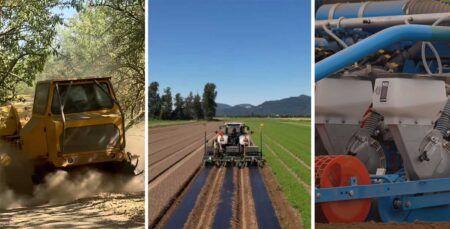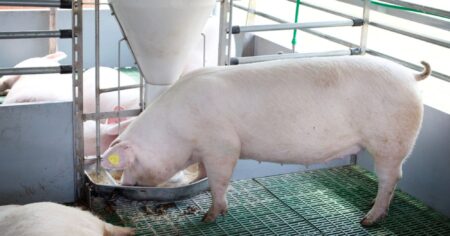You’ve done everything right. You’ve calibrated your sprayer, checked the nozzles, made smart herbicide decisions, and followed the label to a T. And yet, weeds still stand tall at harvest. When weeds have developed such prominent herbicide resistance, what options are left?
First developed in Australia in the early 2000s, the seed impact mill is a promising new tool for halting weeds in their tracks. Fitted to the back of the combine, the implement mechanically grinds weed seeds so they are no longer viable. The ultimate goal is to reduce the weed seed bank and minimize risk in following years.
“Every single year, we’re seeing more and more weeds being resistant to herbicides with less and less solutions,” said Ben Morrow, marketing manager for Redekop, a Canadian company that manufactures seed impact mills. “This is another tool in your toolbox to fight against that.”
Combine Requirements
Three companies offer seed impact mills, although only Redekop is based in North America. While new combines may offer preattached seed impact mills, retrofitting existing combines can be difficult. Technicians experienced in this technology may be hard to find.
Ole Norgaard, an organic small-grains farmer in Montana, installed a Harrington Seed Destructor from Australia on his combine a couple years ago. He’s had to rely on the manufacturer for installation and service direction. “Nobody out in this part of the world installs these units,” he said. “I had to install it myself. That was a major job, because everything had to be done correctly.”
A Class 7 or greater combine is typically required to operate a seed impact mill.
How Seed Impact Mills Work
In most combines, a baffle separates the chaff fraction from the straw steam and directs it into the seed impact mill. Once inside, the chaff fraction goes through a device similar to a hammer mill before exiting out the back of the combine.
“The metal inside is constantly spinning at 2,500–3,000 rpm,” said Ram Yadav, a specialty crop weed scientist at Ohio State University. “Anything going through the impact mill is going to get pulverized.”
Research from Redekop found that weed seeds are nonviable after being hit at least four times. Although seeds may look intact when blown out of the mill, the high-speed collisions reduce their ability to thrive.
“Usually, even if it’s sort of an intact seed, the seed coat is broken, and it has to germinate right then, and the frost will kill it,” said Michael Flessner, an Extension weed scientist at Virginia Tech. “Most of them don’t even try to come up, from what we’ve seen in our testing.”
Are Seed Impact Mills Effective?
Seed impact mills have been tested in soybean and wheat fields with promising results. The technology targets all weed seeds that enter the impact mill, including waterhemp and Palmer amaranth.
An Iowa State University study found that an impact mill treatment reduced germinable seeds in soybean fields by around 87%. A Virginia Tech study was even more promising. There, researchers fed soybean and wheat chaff through seed impact mills and tested weed seed germination. They found the impact mill killed 98% of 10 weed species seeds in soybean chaff and 91–96% of ryegrass species in wheat chaff, when harvesting in optimal conditions.
It’s important to remember the impact mill only impacts seeds that enter the combine. “By the time you’re harvesting your soybeans, [weed plants] might have already set a large number of seeds on the ground, which you will never pick up,” Yadav said. “In the Midwest, that can range anywhere from 10–50% depending on the time of harvest.”
Weed plants can spread seed when disturbed at harvest, accounting for 2–15% of seed loss, Yadav said.
“If you can manage to capture [weed] seeds while harvesting, it’s very likely you’re going to destroy them through the impact mills,” he said. “You can increase the percentage of captured weed seeds by harvesting soybeans on time. Make sure you harvest your weedy fields first, so that you can capture those weed seeds while they’re still on the plant.”
While seed impact mills can be used in cornfields, they are less effective.
“The problem is, with a corn header, not many weed seeds come into the combine,” Flessner said. “Most of them will go through the header with the cornstalks and leaves. Sixty or 70% of the weed seeds are probably being lost to the header, if not more.”
Reducing the Weed Seed Bank
The overall goal of systems such as the seed impact mill is to reduce the weed seed bank. While results are less immediate than those of typical herbicide passes or other weed control methods, seed impact mills seem to reduce weed emergence year-over-year.
“With successful implementation, we should drive our weed seed banks down over time,” Flessner said. “The question is, how many years do we have to do this before we see that reduction? In some of the fields we’ve tested, we’ve seen a 25–30% reduction in the number of emerged weed plants the next year after one use.”
Norgaard, the farmer in Montana, said he began using a seed impact mill on his farm three years ago. He said he hasn’t seen a change yet but remains committed to the process. “It takes six to eight years before you start seeing the impact,” he said. “It takes time. It’s not an overnight solution. It’s another tool in the toolbox.”
Cost to Implement
Costs for seed impact mills can vary greatly, depending on combine model, attachment system, and installation fees. Ongoing maintenance costs, as well as extra fuel costs to run the machine, should also be considered.
Virginia Tech’s Flessner said he has seen prices start around $70,000. Although the up-front cost is high, breaking down the price per acre makes it much closer to the cost of a typical herbicide pass.
“Depending on a lot of factors that go into it, on average, the cost was about $12 an acre,” Flessner said. “That’s amortizing the purchase price, the maintenance, the extra fuel, the life of the equipment, into a cost per acre.”












